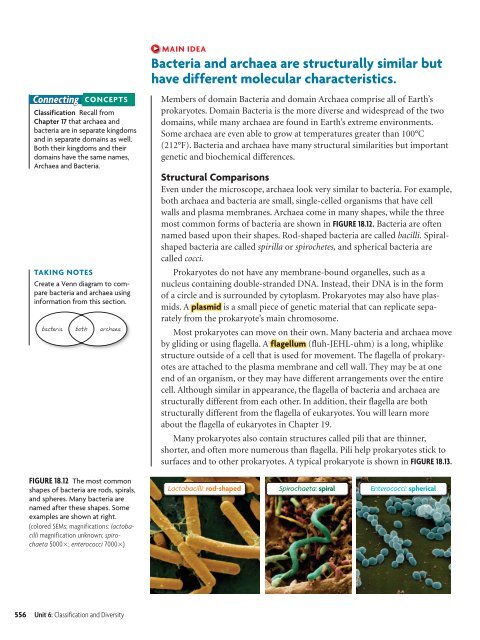18.1 Studying Viruses and Prokaryotes
18.1 Studying Viruses and Prokaryotes
18.1 Studying Viruses and Prokaryotes
You also want an ePaper? Increase the reach of your titles
YUMPU automatically turns print PDFs into web optimized ePapers that Google loves.
Connecting CONCEPTSClassification Recall fromChapter 17 that archaea <strong>and</strong>bacteria are in separate kingdoms<strong>and</strong> in separate domains as well.Both their kingdoms <strong>and</strong> theirdomains have the same names,Archaea <strong>and</strong> Bacteria.TAKING NOTESCreate a Venn diagram to comparebacteria <strong>and</strong> archaea usinginformation from this section.bacteriabotharchaeaFIGURE <strong>18.1</strong>2 The most commonshapes of bacteria are rods, spirals,<strong>and</strong> spheres. Many bacteria arenamed after these shapes. Someexamples are shown at right.(colored SEMs; magnifications: lactobacillimagnification unknown; spirochaeta5000; enterococci 7000)MAIN IDEABacteria <strong>and</strong> archaea are structurally similar buthave different molecular characteristics.Members of domain Bacteria <strong>and</strong> domain Archaea comprise all of Earth’sprokaryotes. Domain Bacteria is the more diverse <strong>and</strong> widespread of the twodomains, while many archaea are found in Earth’s extreme environments.Some archaea are even able to grow at temperatures greater than 100°C(212°F). Bacteria <strong>and</strong> archaea have many structural similarities but importantgenetic <strong>and</strong> biochemical differences.Structural ComparisonsEven under the microscope, archaea look very similar to bacteria. For example,both archaea <strong>and</strong> bacteria are small, single-celled organisms that have cellwalls <strong>and</strong> plasma membranes. Archaea come in many shapes, while the threemost common forms of bacteria are shown in FIGURE <strong>18.1</strong>2. Bacteria are oftennamed based upon their shapes. Rod-shaped bacteria are called bacilli. Spiralshapedbacteria are called spirilla or spirochetes, <strong>and</strong> spherical bacteria arecalled cocci.<strong>Prokaryotes</strong> do not have any membrane-bound organelles, such as anucleus containing double-str<strong>and</strong>ed DNA. Instead, their DNA is in the formof a circle <strong>and</strong> is surrounded by cytoplasm. <strong>Prokaryotes</strong> may also have plasmids.A plasmid is a small piece of genetic material that can replicate separatelyfrom the prokaryote’s main chromosome.Most prokaryotes can move on their own. Many bacteria <strong>and</strong> archaea moveby gliding or using flagella. A flagellum (fluh-JEHL-uhm) is a long, whiplikestructure outside of a cell that is used for movement. The flagella of prokaryotesare attached to the plasma membrane <strong>and</strong> cell wall. They may be at oneend of an organism, or they may have different arrangements over the entirecell. Although similar in appearance, the flagella of bacteria <strong>and</strong> archaea arestructurally different from each other. In addition, their flagella are bothstructurally different from the flagella of eukaryotes. You will learn moreabout the flagella of eukaryotes in Chapter 19.Many prokaryotes also contain structures called pili that are thinner,shorter, <strong>and</strong> often more numerous than flagella. Pili help prokaryotes stick tosurfaces <strong>and</strong> to other prokaryotes. A typical prokaryote is shown in FIGURE <strong>18.1</strong>3.Lactobacilli: rod-shaped Spirochaeta: spiral Enterococci: spherical556 Unit 6: Classification <strong>and</strong> Diversity
















